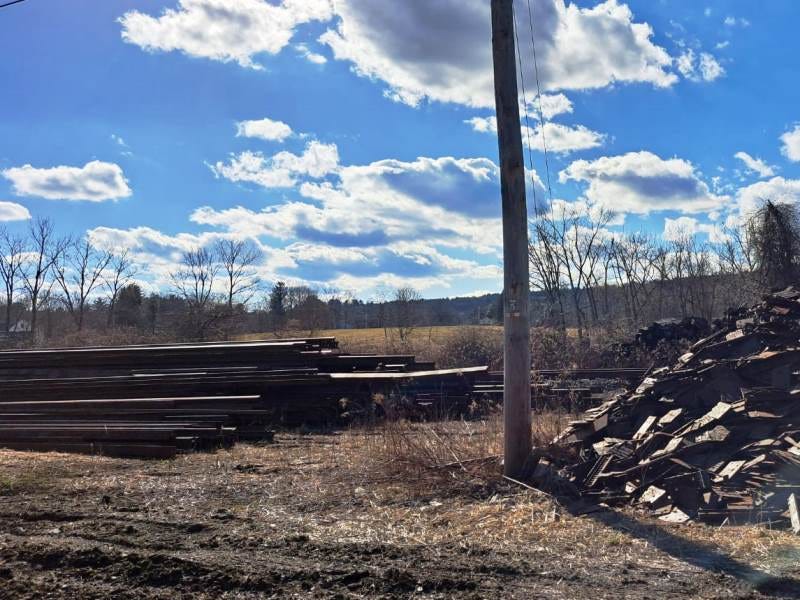This photo, which I took a few days ago, shows piles of scrap steel left from the upgrade to the Berkshire Housatonic Line. I’m sure that it will be hauled away and sold for remanufacture. Metal is valuable. Even the fellow who changed some of my locks recently had containers in his van for different types of metal scrap.
But steel is not a topic that politicians and activists are eager to discuss. Modern economies are dependent on it so when someone is promoting electric vehicles or wind turbines or high-speed rail they make it sound as though the raw materials and equipment needed will simply appear, like mushrooms on a log without having climate impact.
I’ve been wanting to write about this and my job is easy now because I’ve received a new release from Low Tech Magazine entitled, “How to Escape From the Iron Age? We cannot lower carbon emissions if we keep producing steel with fossil fuels.” This publication always has a lot of history as well as discussion of current applications, and it’s heavily footnoted for those who want to look up all the sources.
The main point of the piece is that there’s no way to produce steel without fossil fuels at the rate we now use it. As you’ll see, the conclusions are in line with many of the points I make here at Home Ecology. I think you’ll find the article thought-provoking and have pulled out a few passages here to give you a taste:
1
The continuous growth of the global steel output makes a circular flow of resources impossible. It takes decades before most steel becomes available for recycling. For example, there is 543 Mt of steel stocked in ships. The scrap available for recycling in 2021 corresponds to the production level of 1965 when global steel production was less than one-quarter of what it is today (450 Mt). Consequently, the other three quarters need to be produced in blast furnaces using coal and freshly mined iron ore.
2
A second obstacle is the continuous development of higher grades of steel. There are now over 2,500 different types of steel with a variety of properties, such as increased strength, tolerance to high temperatures, or corrosion resistance. Although these higher quality steels can be produced in electric arc furnaces, they are not made from scrap, and they have much higher energy use.
3
The planned switch to low-carbon energy sources and the electrification of heating and transport technologies will not decrease our dependency on the steel industry – on the contrary. A low-carbon power grid requires much more steel (and other materials) than an infrastructure based on fossil fuels. Wind and solar power are very diffuse power sources compared to fossil fuels. Therefore, it takes much more materials (and land) to produce the same energy. In jargon, wind and solar have low “power density” or high “material intensity.”
And from the conclusion:
All our basic needs – and more – could be supplied with much less steel involved. For example, we could make cars lighter by making them smaller. That would bring energy savings without the need for energy-intensive high-grade steel. We could replace cars with bicycles and public transportation so that more people share less steel. Such changes would also reduce the need for steel in the road network, the energy infrastructure, and the manufacturing industry. We would need fewer machine tools, shipping containers, and reinforced concrete buildings. Whenever steel intensity is reduced, the advantages cascade throughout the whole system. Preventing corrosion and producing steel more locally from local resources would also reduce energy use and emissions.
Transportation infrastructure is usually talked about in terms of fuel use or air pollution, but the article highlights the important of smaller cars, not buying new cars if you don’t have to, and to switching to other forms of transport - not simply buying an EV.
Is this hard to swallow? It’s certainly a big challenge for car-dependent America. I just wish more Americans knew how pleasant it is to take the train. Think of it: the vast majority of my fellow citizens have never been on a train! Even here in the northeast, where we do have trains, people don’t realize what exists on our doorstep. Just the other day I met a man who regularly drives to and from Boston and had no idea that there is a train service once a day in each direction. It took me a while to convince him otherwise. (I used to have the same experience when I spoke at Train Campaign meetings.)
But this isn’t true across the world - and it’s not just China. Ukraine continues to improve its rail system. Mexico is building train lines. And I’ve been happy to read about the growing demand in Europe for improved and expanded train routes, including changes to the way the Channel Tunnel service is run. (Read about it here.) This led me to look for photos of our first trip through the Chunnel, before it officially opened, with a British friend and all our children. What an incredible development that was, and I long to see similar transformative developments happen here in America.
We should be putting the money and skills - and the steel - devoted to car manufacture to public transportation, because that’s what will really make the difference, now and in the years to come.
Incidentally, what a shame it is that the $50 million invested by Massachusetts in that upgrade to the Berkshire Line is not benefiting citizens as intended. The only beneficiary is a privately held freight company because our legislators won’t move on a project that offers what is probably the best return on investment of any proposed rail project in the United States. (I’ve told everyone I’m taking a sabbatical from that project, but it’s often the thing I end up talking to new acquaintances about.)





